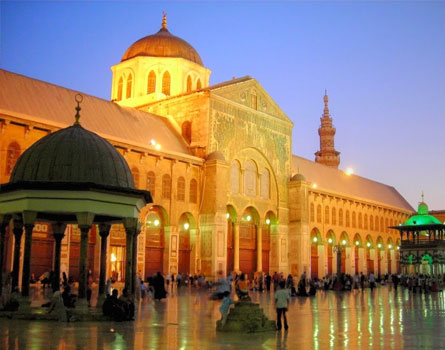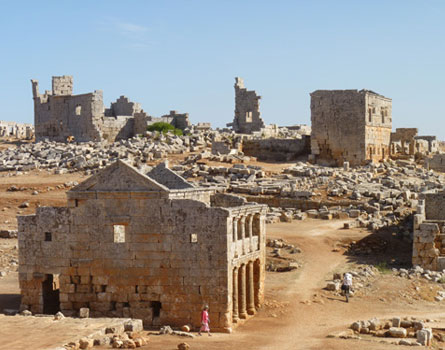Syria
Country statistics

Land area: 71,062 sq miles (184,051 sq km)
Total area: 71,498 sq miles (185,180 sq km)
Population (2010 est.): 22,198,110 (growth rate: 1.9%); birth rate: 24.4/1000; infant mortality rate: 16.18/1000; life expectancy: 74.4; density per sq miles: 272
Capital City: Damascus
Monetary unit: Syrian pound
Languages: Arabic (official); Kurdish, Armenian, Aramaic, Circassian widely understood; French, English somewhat understood
Ethnicity/race: Arab 90.3%, Kurds, Armenians, and other 9.7%
Religions: Islam (Sunni) 74%; Alawite, Druze, and other Islamic sects 16%; Christian (various sects) 10%; Jewish (tiny communities in Damascus, Al Qamishli, and Aleppo)
Country introduction

Syria is located in South-western Asia, north of the Arabian Peninsula in the Middle East, at the eastern end of the Mediterranean Sea. It is bordered by Turkey on the north, Lebanon and Israel on the west, Iraq on the east, and Jordan on the south.
Syria is a land of great diversity, starting from the coast, mountains and steppe ending in the Syrian Desert. With about 180 km (110 miles) along the Mediterranean Sea, the coast lies between Turkey and Lebanon, and it includes both areas of sandy shores, cliffs and rocky headlands. From "Ras Al-Basit" to "Ras Ibn Hani" there are rounded gulfs like "Minet El-Baida" that once sheltered the great kingdom of Ugarit.
The coastal mountainous range borders the coastal plain and runs from north to south. The mountains have an average width of 35 km (21 miles), and their altitude declines from a modest 1,729 m (5,673 ft) in the north (east of Lattakia) to 1,602 m (5,256 ft) at Jebel Aqra to 600 m (1,969 ft) in the south, at the gap near Homs. Directly to the east of the mountains is the "Ghab" Depression, a 75 km (46 miles) longitudinal trench that contains the valley of the Orontes River. The main ridge rises to a maximum height of 2,629 m (8,625 ft) near Al-Nabk, while the average height is between 1,828 and 2,133 m (6,000 and 7,000 ft). The highest point in Syria is Mount Hermon (Jebel al Shaykh) at 2,814 m (9,232 ft) on the Lebanese border.
This semi circle of fertile land encompasses the Syrian Desert. This is where agriculture first began. Starting from the "Ghab" depression it extends eastward to create the most important geographical feature in Syria. With the addition of the Dam on the Euphrates, and modern irrigation this part of Syria is the area with the biggest production of cotton.
The Syrian Desert comprises about 58 % of the Syrian territory. These undulating plains, often called the steppe, have a general elevation between 298 and 499 m (980 and 1,640 ft); they are rarely less than 250 m (820 ft) above sea level. The area is not a sand desert but comprises rock and gravel steppe; a mountainous region in the south-central area is known as al Hamad, and the main oasis is that at the foot of the Palmyrene Mountains which has very sulfurous water springs.
The culture

The impact of Syrian culture has been felt over the course of thousands of years. Syrian scholars and art both had an impact on foreign cultures such as the Romans. It is now believed that a culture on par with Mesopotamia and Egypt was once seated in Syria. The Syrian culture puts great importance on family, religion, and betterment of the self. Dances and celebrations of old can typically be found at marriages or when a child is born into a household.
Syrians have a fierce pride in their traditions of poetry, both oral and written. Syrian writers have long played a critical role in the Arabian literary world for hundreds of years. They had a hand in the cultural and literary revival in the 19th century known as al-Nahda. Various political institutions through the centuries have had great impact on Syrian literature in general. Harsh police states enforced strict censorship on many works. Syrian writers responded by moving abroad, spreading their culture with them. They also adopted the methodology of some Victorian era writers and created new genres that took subtle swipes at the ruling class and their laws.
Syria is a primarily a Muslim nation which comprises of approximately 87% of the population with about 74% being Sunni. The biggest holidays for Muslims in Syria are Eid ul-Fitr. This is observed after Ramadan and Eid al-Adha, which is celebrated at the conclusion of Hajj. Christmas and Easter holidays are observed by the Christian population of Syria. Diwali (Festival of Light) is among the most biggest holidays celebrated by Hindus, Jains and Sikhs who live in Syria. Jews who reside in Syria celebrate numerous celebrations, which include the Passover (Spring Feasts of Pesach) and Shavuot, the Rosh Hashanah (start of the Year), Yom Kippur (Day of Atonement), Sukkot (Tabernacles), and Shemini Atzeret. Other festivities include the Palmyra Desert Festival which is celebrated in the first week of May in the ruins of the spectacularly set ancient oasis town of Palmyra. During the day the Bedouin handicrafts are available for sale and spectators enjoy the spectacle of camel races through the ruins. As the sun sets, live performances of folk music and dancing fill the night sky.
The Syrian cuisine is rich and varied in its ingredients and is linked to the region of Syria where a specific dish originated. Syrian food mostly consists of Southern Mediterranean, Greek, and South-west Asian dishes. Some Syrian dishes also evolved from Turkish and French cooking. Dishes include the shish kebab, stuffed zucchini, yabra' (stuffed grape leaves, the word yapra' derives from the Turkish word 'yaprak' meaning leaf). The main dishes that form Syrian cuisine are kibbeh, hummus, tabbouleh, fattoush, labneh, shawarma, mujaddara, shanklish, pastırma, sujuk and baklava. Baklava is made of filo pastry filled with chopped nuts and soaked in honey. Syrians often serve selections of appetizers, known as meze, before the main course. za'atar, minced beef, and cheese manakish are popular hors d'œuvres. The Arabic flatbread khubz is always eaten together with meze.
Attractions & landmarks

Along with other Middle Eastern countries such as Israel and Iraq, Syria was part of the cradle of civilisation. Therefore, one of the most important things to do whilst in Syria is to take a tour of the historic sites of this ancient country. The first place to visit is the capital Damascus, which is the largest and oldest inhabited cities in the world, as old as 5000 BC. The old city of Damascus is surrounded by what was once a Roman wall. The city offers fascinating oriental bazaars and marvelous monuments. The centre of the city is Martyrs' Square where most of the restaurants and hotels are located. The city's main market, the colourful Souq al-Hamidiyyais, is the largest and the central souk in Syria, which is located inside the old walled city of Damascus next to the Citadel. Opposite the end of the market is the Umayyad Mosque or Great Mosque of Damascus. It is a jewel of Islamic architecture, with several gorgeous mosaics and three original minarets. It is one of the largest sacred mosque, as well as the world's oldest (built 3000 years ago). Visitors can view stones from the Roman ruins that were used to construct the mosque. Decorative Roman carvings remain on some of the stones used to construct the exterior walls. The mosque has a large yard and spacious prayer hall as well as some original mosaics in the 8th century.
Aside from Damascus, Syria has other cities that have great historical value and cultural importance. Among these are Aleppo, which has breathtaking views; Dier-ez-Zur, a desert town near the infamous Euphrates River where the ancient civilization began to flourish and Latakia, a port city where Saladin's Castle can be found. In the old town there are also a large fortress called the Citadel of Aleppo. The building is considered one of the oldest and largest palace in the world. Another famous building near Aleppo are the ruins of the Basilica of St. Simeon Splendour.
Palmyra is an ancient city in Syria, located 346 km (215 miles) in the northeast of Damascus. In this city there are many sites that still remain. Starting from the Stone Bel, Ba'al-Shamin Stone Tomb Stone to Palmyra. One of the highlights in Palmyra, is every traveler are allowed to hire a camel and local guide to explore the city.
Other famous tourist destinations in Syria are the Dead Cities. The Dead Cities namely Jerada, Ruweiha, Serjilla and Al-Bara are the main attractions around Aleppo. These are a series of ghost towns that lie among the limestone hills between the Aleppo-Hama highway in the east and the Orontes River in the west. They date from the time when this area was part of the hinterland of the great Byzantine city of Antioch. One of the Dead Cities, Al Bara, has pyramidal tombs located along with what used to be grand archways that stand on a modern farmland.